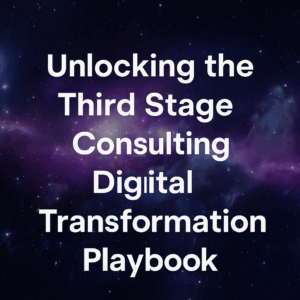Digital transformations are complex endeavors. With numerous details and moving parts to consider, understanding the concept and ensuring its success can be overwhelming. The key question is: how can we simplify digital transformation? This is the topic we will explore today.

When delving into the world of digital transformation, the intricate details and complexity can be daunting. The myriad of technical terms, diverse technologies, and numerous considerations can be overwhelming. Amidst this complexity, it is vital not to lose sight of the fundamental principles of digital transformation. Our objective today is to distill the essence of digital transformation into a comprehensible format, enabling you to manage your projects more effectively.
Table of Contents
ToggleLess Technical Scope
One of the primary strategies we recommend to clients aiming to simplify their digital transformation is to consider reducing the technical scope of their project. While it might appear counter-intuitive to decrease technological components during a digital transformation, many organizations often overextend. They attempt to incorporate an excessive amount of technology in a limited timeframe, consequently overlooking crucial aspects of digital transformation. While I will delve deeper into these vital components later, the essential point is to concentrate on those high-value areas that provide maximum returns for your business organization while minimizing risk. Overambitious approaches often lead to unnecessary complexities in the transformation process, diverting attention from more crucial areas. Furthermore, this could result in the acquisition of technology that remains underutilized, offering no substantial value. Thus, to genuinely simplify digital transformation, it’s paramount to streamline the technology aspect, focusing primarily on areas promising immediate and enduring business value.
Point Solutions
To reduce complexity and streamline digital transformation, organizations should prioritize technologies that address specific business needs rather than adopting expansive systems intended to oversee an entire enterprise. Implementing point solutions, or functionally-focused solutions, can be a strategic approach. These solutions concentrate on addressing a limited set of issues, rather than attempting to remedy every organizational challenge or improvement area.
For instance, instead of introducing a broad, enterprise-wide technology that would be both time-consuming and costly to implement, and would introduce significant risks, organizations might consider targeting specific functional domains with immediate improvement opportunities. If the primary concern is enhancing sales and revenue generation, a Customer Relationship Management (CRM) system might be a more appropriate and straightforward solution. Conversely, if talent management and human resources present challenges, HR technologies such as Workday, UKG, or other Human Capital Management (HCM) technologies may be better suited. Moreover, for organizations facing challenges in managing their supply chains efficiently, specific supply chain management solutions could be more beneficial than a holistic, enterprise-wide system.
In summary, it’s advantageous for organizations to narrow their technology deployment focus, concentrating on point solutions or sector-specific solutions. This approach is often more effective than attempting to deploy extensive technology across the entirety of the enterprise.
Focus On People
The human aspect of digital transformation is arguably the most challenging and intricate facet of the entire process. While technology can introduce a multitude of complexities, risks, and hurdles during implementation, these technical difficulties are often overshadowed by the challenges posed by human-centric aspects. Human behavior is inherently resistant to change. Introducing organizational change invariably results in unforeseen challenges and intricacies.
Interestingly, dedicating substantial effort to this particularly intricate component of digital transformation, namely the human or change management element, is more likely to mitigate complexities. Implementing a comprehensive change management plan, having a clear change strategy, and purposefully addressing the human elements of digital transformation are paramount methods to diminish complexity and risk within the process.
Focus on Alignment
One of the most effective strategies to minimize complexity and risk in an organization’s digital transformation is to emphasize alignment. More precisely, it is crucial to address and rectify any misalignment present within an organization. Inherent in every organization are issues like internal politics, organizational psychology, diverse individual personalities, and various facets of organizational behavior. These elements can lead to misalignment, introducing further complexity.
The primary objective should be to identify the sources of misalignment, understand its nature, and ensure everyone comprehends the goals and implications of the digital transformation. Achieving this can transform potential obstacles, caused by misalignment, into supportive forces that enhance the project’s momentum and foster alignment.
For illustration, consider an organization where the executive team is divided and lacks a unified vision. Such a setting makes it highly improbable for any digital transformation to succeed, regardless of the excellence of the technology, implementation team, or the suitability of the chosen solution. The inherent misalignment is likely to produce numerous challenges, making success difficult. Thus, it is imperative to address these alignment issues, ensuring everyone is synchronized, to effectively reduce the intricacies of digital transformation.

Benefits Realization and Value Creation
Another method to diminish complexity in digital transformation is by offering clear focus and direction to the digital transformation team. This can be achieved by setting measurable targets and outlining expectations for the digital transformation’s impact on the organization. While many emphasize metrics such as project completion timelines and budget adherence, which are undeniably vital, it’s imperative to also assess the tangible impact of the digital transformation on the organization post-implementation.
Establishing a detailed roadmap outlining expected business benefits, value realization, and a value creation plan is crucial. This not only ensures the attainment of anticipated business value from technological investments but also serves as a guiding principle for the digital transformation team. By concentrating on deliverables that yield genuine business value, the team is less likely to deviate or become entrenched in technological intricacies that don’t enhance the organization’s value. Therefore, a significant step in reducing complexity in your digital transformation is honing in on these quantifiable elements of the process.

I would enjoy brainstorming ideas with you if you are looking to strategize an upcoming transformation or are looking at selecting an ERP system, so please feel free to contact me at eric.kimberling@thirdstage-consulting.com. I am happy to be a sounding board as you continue your digital transformation journey.





